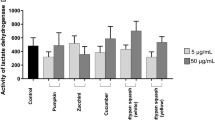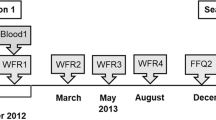Abstract
Objective: To assess the effects in humans of regular ingestion of black tea on haemostasis-related variables and cell adhesion molecules.
Design: Twenty-two subjects were recruited from the general population to a randomised-controlled crossover study. Subjects stopped drinking tea, apart from that provided, for the duration of the study. During a 4-week baseline period all subjects drank 5 cups/day (250 ml) of hot water. The effects of 5 cups/day of black tea for 4 weeks were then compared with hot water. Platelet aggregation in response to three doses of collagen and ADP, plasma concentrations of coagulation and fibrinolytic factors (fibrinogen, factor VII, tPA, PAI-1) and plasma concentrations of cell adhesion molecules (soluble P-selectin, E-selectin, ICAM-1, VCAM-1) were assessed twice, one week apart, at the end of each period. Twenty-four hour urinary concentration of 4-O-methylgallic acid (4OMGA), assessed once at the end of each period, was used as a marker of black tea polyphenol intake.
Results: The 24 h urinary excretion of 4OMGA was increased during regular ingestion of black tea in comparison to hot water (P<0.0001). Black tea resulted in lower soluble P-selectin (P=0.01) in comparison to hot water, but did not influence other adhesion molecules. Soluble P-selectin was significantly correlated with mean collagen-stimulated platelet aggregation at baseline (r=0.61, P=0.003), and during regular ingestion of hot water (r=0.70, P<0.0001) and black tea (r=0.51, P=0.01). However, platelet aggregation was not different between the black tea and hot water periods for collagen- or ADP-stimulated aggregation at any dose. Coagulation and fibrinolytic factors were also not different between periods.
Conclusions: The effect of black tea on soluble P-selectin provides a potential mechanism for cardiovascular benefits of regular ingestion of tea.
Sponsorship: This study was supported by grants from the Tea Trade Health Research Association and the National Heart Foundation of Australia.
European Journal of Clinical Nutrition (2001) 55, 881–886
This is a preview of subscription content, access via your institution
Access options
Subscribe to this journal
Receive 12 print issues and online access
$259.00 per year
only $21.58 per issue
Buy this article
- Purchase on Springer Link
- Instant access to full article PDF
Prices may be subject to local taxes which are calculated during checkout
Similar content being viewed by others
References
Blann AD, Lip GY, Beevers DG & McCollum CN (1997) Soluble P-selectin in atherosclerosis: a comparison with endothelial cell and platelet markers Thromb. Haemostasis 77 1077–1080
Blann AD, Noteboom WM & Rosendaal FR (2000) Increased soluble P-selectin levels following deep venous thrombosis: cause or effect? Br. J. Haematol. 108 191–193
Conquer JA, Maiani G, Azzini E, Raguzzini A & Holub BJ (1998) Supplementation with quercetin markedly increases plasma quercetin concentration without effect on selected risk factors for heart disease in healthy subjects J. Nutr. 128 593–597
de Maat MPM, Pijl H, Kluft C & Princen HMG (2000) Consumption of black and green tea has no effect on inflammation, haemostasis and endothelial markers in smoking healthy individuals Eur. J. Clin. Nutr. 54 757–763
Dong ZM, Chapman SM, Brown AA, Frenette PS, Hynes RO & Wagner DD (1998) Combined role of P- and E-selectins in atherosclerosis J. Clin. Invest. 102 145–152
Dong ZM, Brown AA & Wagner DD (2000) Prominent role of P-selectin in the development of advanced atherosclerosis in apoE-deficient mice Circulation 101 2290–2295
Formica JV & Regelson W (1995) Review of the biology of quercetin and related bioflavonoids Food Chem. Toxicol. 33 1061–1080
Frijns CJ, Kappelle LJ, van Gijn J, Nieuwenhuis HK, Sixma JJ & Fijnheer R (1997) Soluble adhesion molecules reflect endothelial cell activation in ischemic stroke and in carotid atherosclerosis Stroke 28 2214–2218
Gearing AJH & Newman W (1993) Circulating adhesion molecules in disease Immunol. Today 14 506–512
Gerritsen ME, Carley WW, Ranges GE, Shen CP, Phan SA, Ligon GF & Perry CA (1995) Flavonoids inhibit cytokine-induced endothelial cell adhesion protein gene expression Am. J. Pathol. 147 278–292
Hamsten A, de Faire U, Walldius G, Dahlen G, Szamosi A, Landou C, Blomback M & Wiman B (1987) Plasminogen activator inhibitor in plasma: risk factor for recurrent myocardial infarction Lancet ii 3–9
Harbowy ME & Ballentine DA (1993) Tea chemistry Crit. Rev. Plant Sci. 16 415–480
Hertog MGL & Hollman PCH (1996) Potential health effects of the dietary flavonol quercetin Eur. J. Clin. Nutr. 50 63–71
Hertog MG, Feskens EJ, Hollman PC, Katan MB & Kromhout D (1993) Dietary antioxidant flavonoids and risk of coronary heart disease Lancet 342 1007–1011
Hodgson JM, Morton LW, Puddey IB, Beilin LJ & Croft KD (2000a) Gallic acid metabolites are markers of black tea intake in humans J Agric. Food Chem. 48 2276–2280
Hodgson JM, Puddey IB, Croft KD, Burke V, Mori TA, Abu-Amsha Caccetta R & Beilin LJ (2000b) Acute effects of black and green tea ingestion on lipoprotein oxidation Am. J. Clin. Nutr. 71 1103–1107
Hollman PCH, Feskens EJM & Katan MB (1999) Tea flavonols in cardiovascular disease and cancer epidemiology Proc. Soc. Exp. Biol. Med. 220 198–202
Holvoet P & Collen D (1997) Thrombosis and atherosclerosis Curr. Opin. Lipidol. 8 320–328
Janssen K, Mensink RP, Cox FJ, Harryvan JL, Hovenier R, Hollman PC & Katan MB (1998) Effects of the flavonoids quercetin and apigenin on hemostasis in healthy volunteers: results from an in vitro and a dietary supplement study Am. J. Clin. Nutr. 67 255–262
Kang WS, Lim IH, Yuk DY, Chung KH, Park JB, Yoo HS & Yun YP (1999) Antithrombotic activities of green tea catechins and (−)-epigallocatechin gallate Thromb. Res. 96 229–237
Keli SO, Hertog MGL, Feskens EJM & Kromhout D (1996) Dietary flavonoids, antioxidant vitamins, and incidence of stroke Arch. Intern. Med. 156 637–642
Kobuchi H, Roy S, Sen CK, Nguyen HG & Packer L (1999) Quercetin inhibits inducible ICAM-1 expression in human endothelial cells through the JNK pathway Am. J. Physiol. 277 C403–C411
Landolfi R, Mower RL & Steiner M (1984) Modification of platelet function and arachidonic acid metabolism by bioflavonoids. Structure-activity relations. Biochem. Pharmac. 33 1525–1530
Leenen R, Roodenburg AJ, Tijburg LB & Wiseman SA (2000) A single dose of tea with or without milk increases plasma antioxidant activity in humans Eur. J. Clin. Nutr. 54 87–92
Meade TW, Ruddock V, Stirling Y, Chakrabarti R & Miller GJ (1993) Fibrinolytic activity, clotting factors, and long-term incidence of ischaemic heart disease in the Northwick Park Heart Study Lancet 342 1076–1079
Meade TW, Cooper JA, Chakrabarti R, Miller GJ, Stirling Y & Howarth DJ (1996) Fibrinolytic activity and clotting factors in ischaemic heart disease in women Br. Med. J. 312 158 1
Moroney MA, Alcaraz MJ, Forder RA, Carey F & Hoult JR (1988) Selectivity of neutrophil 5-lipoxygenase and cyclo-oxygenase inhibition by an anti-inflammatory flavonoid glycoside and related aglycone flavonoids J. Pharm. Pharmac. 40 787–792
Neiva TJC, Morais L, Polack M, Simoes CMO & D'Amico EA (1999) Effects of catechins on human blood platelet aggregation and lipid peroxidation Phytother. Res. 13 597–600
Pace-Asciak CR, Hahn S, Diamandis EP, Soleas G & Goldberg DM (1995) The red wine phenolics trans-resveratrol and quercetin block human platelet aggregation and eicosanoid synthesis: implications for protection against coronary heart disease Clin. Chim. Acta 235 207–219
Panes J, Gerritsen ME, Anderson DC, Miyasaka M & Granger DN (1996) Apigenin inhibits tumor necrosis factor-induced intercellular adhesion molecule-1 upregulation in vivo Microcirculation 3 279–286
Price DT & Loscalzo J (1999) Cellular adhesion molecules and atherogenesis Am. J. Med. 107 85–97
Rein D, Paglieroni TG, Pearson DA, Wun T, Schmitz HH, Gosselin R & Keen CL (2000a) Cocoa and wine polyphenols modulate platelet activation and function J. Nutr. 130 2120S–2126S
Rein D, Paglieroni TG, Wun T, Pearson DA, Schmitz HH, Gosselin R & Keen CL (2000b) Cocoa inhibits platelet activation and function Am. J. Clin. Nutr. 72 30–35
Ridker PM, Hennekens CH, Roitmanjohnson B, Stampfer MJ & Allen J (1998) Plasma concentration of soluble intercellular adhesion molecule I and risks of future myocardial infarction in apparently healthy men Lancet 351 88–92
Ridker PM, Buring JE & Rifai N (2001) Soluble P-selectin and the risk of future cardiovascular events Circulation 103 491–495
Rohde LE, Lee RT, Rivero J, Jamacochian M, Arroyo LH, Briggs W, Rifai N, Libby P, Creager MA & Ridker PM (1998) Circulating cell adhesion molecules are correlated with ultrasound-based assessment of carotid atherosclerosis Arterioscl. Thromb. Vasc. Biol. 18 1765–1770
Rohde LEP, Hennekens CH & Ridker PM (1999) Cross-sectional study of soluble intercellular adhesion molecule-I and cardiovascular risk factors in apparently healthy men Arterioscl. Thromb. Vasc. Biol. 19 1595–1599
Tsakiris DA, Tschopl M, Jager K, Haefeli WE, Wolf F & Marbet GA (1999) Circulating cell adhesion molecules and endothelial markers before and after transluminal angioplasty in peripheral arterial occlusive disease Atherosclerosis 142 193–200
van het Hof KH, Wiseman SA, Yang CS & Tijburg LBM (1999) Plasma and lipoprotein levels of tea catechins following repeated tea consumption Proc. Soc. Exp. Biol. Med. 220 203–209
Vorster H, Jerling J, Oosthuizen W, Cummings J, Bingham S, Magee L, Mulligan A & Runswick S (1996) Tea drinking and haemostasis: a randomized, placebo-controlled, crossover study in free-living subjects Haemostasis 26 58–64
Wiman B & Hamsten A (1990) Correlations between fibrinolytic function and acute myocardial infarction Am. J. Cardiol. 66 54G–56G
Xu DY, Zhao SP & Peng WP (1998) Elevated plasma levels of soluble P-selectin in patients with acute myocardial infarction and unstable angina. An inverse link to lipoprotein(a) Int. J. Cardiol. 64 253–258
Youdim KA, Martin A & Joseph JA (2000) Incorporation of the elderberry anthocyanins by endothelial cells increases protection against oxidative stress Free Rad. Biol. Med. 29 51–60
Acknowledgements
The authors wish to thank Jim Thom, Nella Giangiulio, Lyn McCahon, Penny Rogers and Susan Ng for their help in carrying out the study.
Author information
Authors and Affiliations
Corresponding author
Rights and permissions
About this article
Cite this article
Hodgson, J., Puddey, I., Mori, T. et al. Effects of regular ingestion of black tea on haemostasis and cell adhesion molecules in humans. Eur J Clin Nutr 55, 881–886 (2001). https://doi.org/10.1038/sj.ejcn.1601231
Received:
Revised:
Accepted:
Published:
Issue Date:
DOI: https://doi.org/10.1038/sj.ejcn.1601231
Keywords
This article is cited by
-
Mechanisms of Protection of the Brain from Ischemic Injury by Components of Tea
Neuroscience and Behavioral Physiology (2014)
-
The effects of tea on psychophysiological stress responsivity and post-stress recovery: a randomised double-blind trial
Psychopharmacology (2007)



